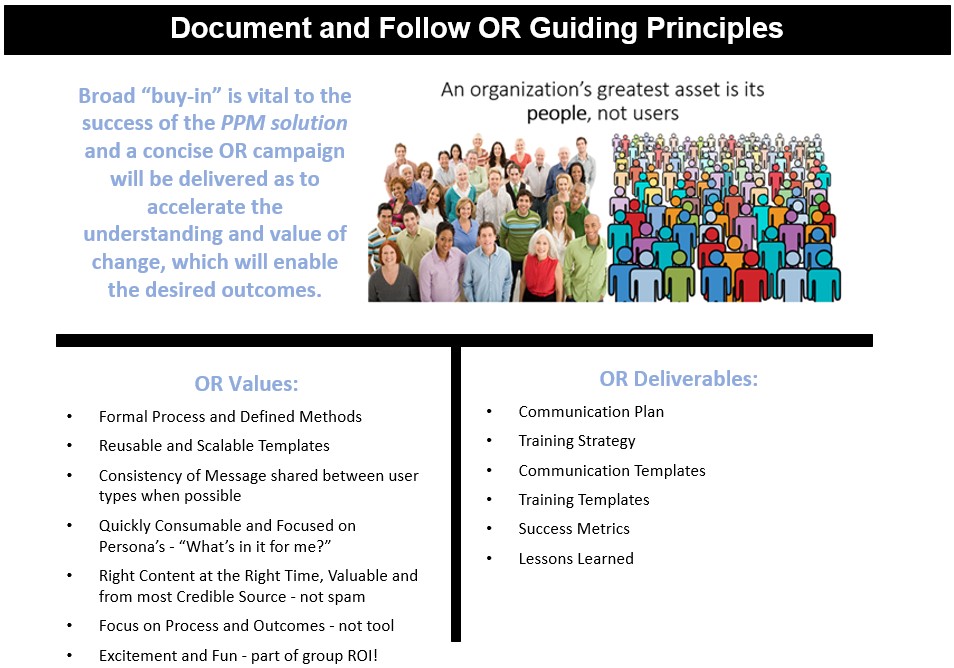Delivering valuable Project and Portfolio Management (PPM) outcomes depends on several factors - process and system maturity, appetite for investment, leader and team skills, understanding user pain and value propositions, internal politics, and changes in reporting structures or key initiatives . . . the list goes on. It even includes changing tools or pivoting to agile and DevOps methodologies. As Practitioners, we may be in a constant state of flux - or worse - flatness. This blog discusses achieving, re-achieving and transparently demonstrating benefits from PPM processes and systems through an adoptable and adaptable Organizational Readiness/Change Management (OR/CM) framework.
We’re all very aware that process and system adoption are imperative to delivering outcomes we not only want, but need. As PPM Practitioners, it is our responsibility and opportunity to ensure that this happens. In my ten years of focusing on PPM, I’ve heard a lot of lip service given to OR. The concepts are relatively simple, but applying them seems difficult. If your group has a mature OR practice, you are in a fortunate and rare circumstance, so bake their knowledge into your practice. But even if you’re like most of us who don’t have a mature support system, you can create and demonstrate value from the PPM-centric concepts below.
This framework may be used by any PPM group, no matter which of the above factors affect your situation. We can build skills progressively without immediately spending resources on expensive training or consultants. As groups see value from OR activities, some do invest further, but I know from experience that this activity can start at the grass-roots level. Many standards are available online; just do a Google or Twitter search (this is how I started my OR journey six years ago). Two of my favorites are the Kotter 8-step process and the ADKAR methodology. I firmly believe that information found online is all you need to start enabling value immediately, because the difficult part is building and working the plan, not understanding concepts.
As I’ve said in previous posts, every environment is different, and OR must be customized (within reasonable cost) to meet unique needs. Most often, knowing your users (people who interact with and gain insights from processes and systems) is uniquely internal and just can’t be purchased. So, I will share some foundational tools I’ve used with success.
Below I describe an OR strategy you can tweak to meet your specifications. This strategy gives guiding principles and communication tools, which helps with campaign scope, tasks and prioritization of OR investments. It is all about people doing processes that profit. You can use it as a starting point to build your own OR checklist, cadence and calendars.

When building a communication plan and training strategy, we should focus on pre-training awareness, hands-on activities and reinforcement/support. I find that getting a concise and resonating message out in front of any change is important, because those affected need to know the value proposition of the investment and impacts being implemented. It also nips misinformation in-the-bud and builds trust and transparency.
The change itself must also be constructed with comprehensive adoption techniques built in, with the lowest user work/input tied directly to highest return/output. Simply put: first the “why,” then the “how,” while reinforcement sustains and enables maturity. I call it the “Organic Audit,” but more on that in part 2 of this blog.
When building content, it adds efficiencies and effectiveness to build with the intent of re-use in different communication mediums. It is imperative to have a consistent message, and much of the material that makes up the OR artifacts can be pre-built well before a change. A standard example of this is a “what’s in it for me” graphic, which may be used in an awareness communication or overview presentation, then included in training and later as part of success realization.
Lookout for part two of this blog, where we discuss additional OR artifacts, processes and effective assessments!
For more, check out the PPM Insights blog series. I encourage you to participate in the best-in-class CA Communities site, where we have access to peers, events and support. You can also reach out to CA Services for individualized business outcome references and analysis. Feel free to post in the comments section of this blog or contact me directly via email and @PPMWarrior.